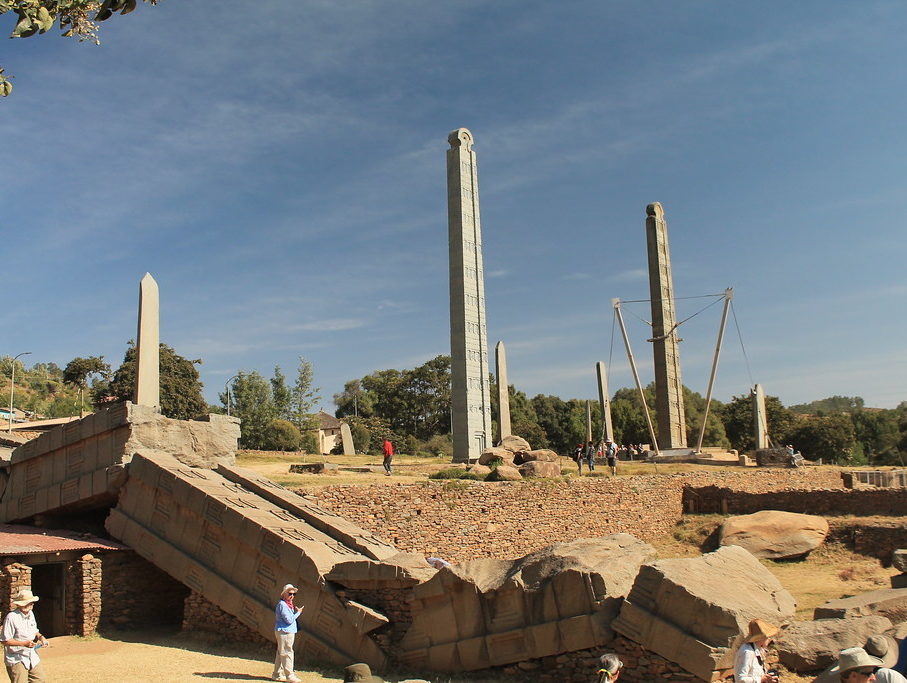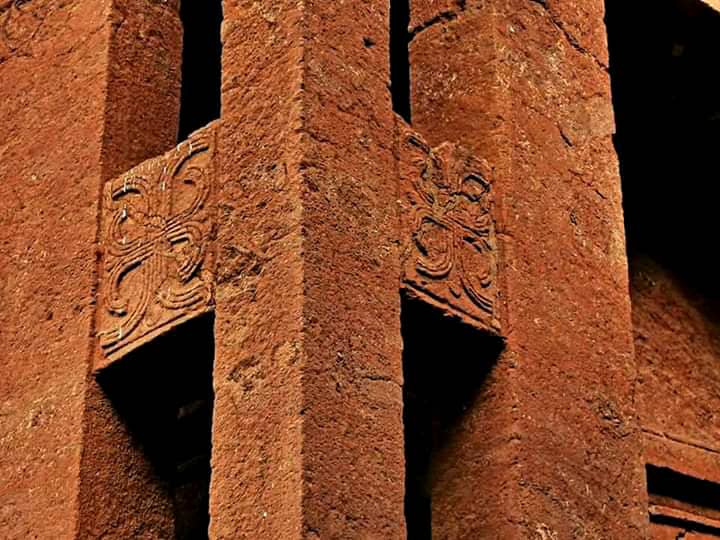Axum Tour

Obelisks and more
The modern town of Axum does not easily show the evidence of the splendors of its glorious past. Nevertheless, the historic footprints are represented by extensive traces of noble buildings with large stone foundations, side by side with the ruins of even more impressive structures such as: temples, fortresses, and rich palaces. The hand of nature in the form of heavy downpours of rain, seems to take the place of systematic excavations, to bring to light some of the long-buried hordes of gold, silver and bronze coins.
Was there a pre-Axum civilization of Ethiopia ?
Yeha: The tantalizing and towering ruins of Yeha’s Temple of the Moon – built more than 2,500 years ago, in Sabaean times, is considered to be Ethiopia’s earliest high civilization. Whether this was a lone shrine of a temple , or part of a city with other similar edifices is not yet ascertained. Nevertheless, the fact that the wall is built with precise-fitting blocks of smoothly polished yellow limestone carefully placed without the use of mortar, leaves no doubt of the superb quality and craftsmanship involved. Apart from the temple, however – which speaks eloquently of the works of a high civilization – little or nothing is known about the people who built this great edifice. This mystery also raises another mystery: how far back does Ethiopian civilization really go? Although inscriptions and fine objects of bronze and other artifacts have been excavated from Yeha since 1909, nothing is uncovered to shade light on the above mysteries.
The Axumite Kingdom
Axum, was a great commercial civilization trading with distant lands, such as Egypt, Arabia, Persia, India, Ceylon, etc. Its main exports were gold, ivory, rhinoceros-horn, hippopotamus hide and slaves. It imported mainly textiles, finished metal wares, and metals to be used for the manufacturing of local crafts.
Pre-Christianity Axum
The stelea erected in Axum seem less like pillars of stone and more like lightning rods to heaven. The purpose of these prodigious monolithic stelea may have been to draw down power from the firmament in a ritual, undoubtedly accompanied by occasional sacrifices. Most of the obelisks have altars at their bases, all aligned towards the rising sun. Four deep holes in the center of one were presumably made to collect blood from the sacrifices. Like many other monolithic Ethiopian works, it is carved to resemble a conventional building – in this case a nine-story tower-house. Of the three tallest stelea, one is still standing, another is lying broken into pieces, but otherwise intact, and the third is being returned to its rightful place from Rome, where it has been standing ever since the Italian Invasion of Ethiopia during the second World War.
Post Christianity Axum
Axum still holds a significant place among the members of the Ethiopian Orthodox Church, because of the Cathedral of St. Mary of Zion. This church was built on the site of a much older church, probably resembling that of Debre Damo, dating from the 4th century AD. Only a platform and the wide stone steps remain from the earlier structure. The Cathedral is the repository of the crowns of some of Ethiopia’s former emperors, and is believed to house the original Ark of the Covenant – thus making St. Mary the holiest sanctuary in Ethiopia.
The significance of Monasticism in the Ethioipian Coptic Church
Debre Damo, uniquely enough, offers that broader horizon of the Ethiopian spiritual entity, and the significant place monasticism holds in the Ethiopian Coptic Church. As is the case with some Ethiopian monasteries, and mainly for religious reasons, women do not have the access to visit this site. The monastery is found on a cliff 24 meters high that makes the entrance an event by itself. Monks lower a safety rope to be tied around the waist and to climb with. This lack of access, may have preserved the art treasures of Debra Damo all through out its 1400 years history.
The treasures include an extensive collection of illuminated manuscripts, some of them not found anywhere else in Ethiopia, and intricate carvings on the beams and ceiling of the ancient church around which the monastery is built. There are also large number of paintings including several that depict the legend of the foundation of Debra Damo by Abuna Aragawi. The monastic community is virtually self- sufficient, growing selected crops and rearing sheep and goats for their milk and meat. The monastery also has its own reservoirs, spectacular caverns hewn deep beneath the surface of the cliff-top centuries ago, somewhat similar to those at the rock-hewn churches of Lalibela.
Modern Tigray
Although Axum was the dominant power of the past, power shifted to the town of Mekele, when it became the capital of Emperor Yohannes IV (1871 – 1889). It is also the present main city of Tigray, and perhaps the fastest growing city in Ethiopia these days. The Emperor’s palace has been turned into a particularly interesting museum, with many exhibits of his time and subsequent historical remains.
The city is also well known as a transit point for the Camel Caravans that bring up salt from the arid lands of the Danakil Depression. This makes the market place an interesting sight to visit. Intrepid visitors can also make excursions into the Danakil to visit some of the Afar nomads that trek across the region. However, please refer to the Nature Tours and Trekking page before doing so.
Lalibela Tour
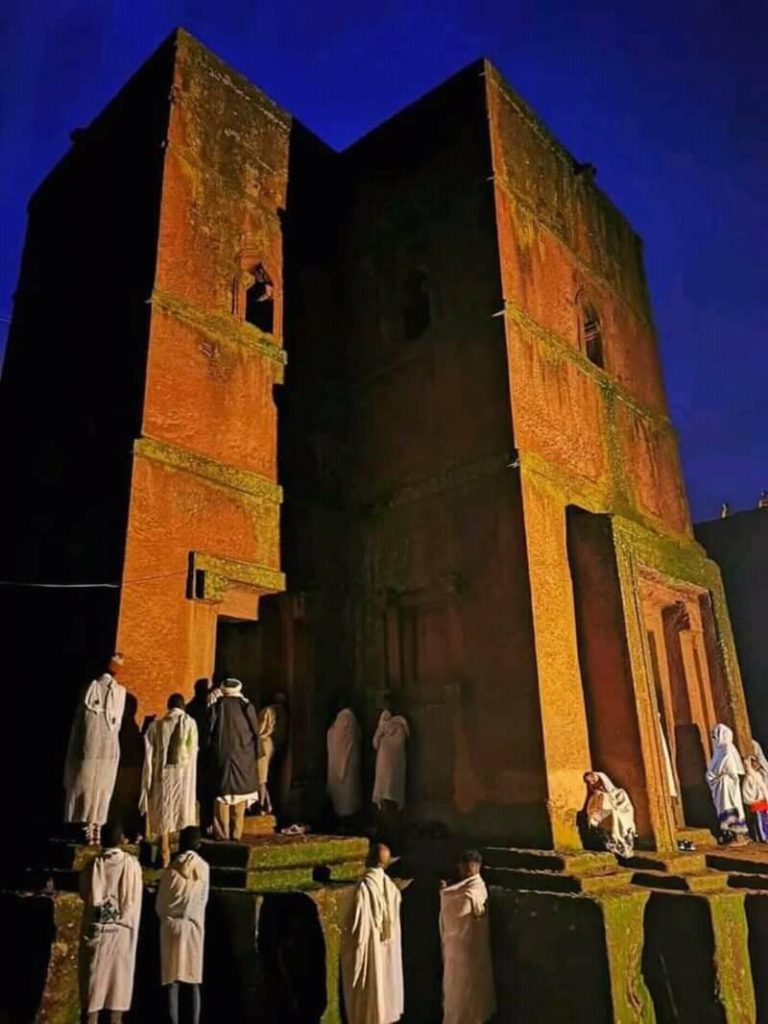
The New Jerusalem
Even after the Seven Wonders of the World have outworn their wonder, the rock hewn churches of Lalibela will always remain intriguing, fascinating and mysterious to any visitor. It is an awe striking phenomena that will always bamboozle any visitor and compel him or her to rediscover the true meaning of wonder.
Rock-hewn Churches
The creation of these rock-hewn churches is ascribed to one of the last kings of the Zagwe dynasty, St. Lalibela, who reigned around the 12th Century A.D. The magnificence of these churches remains hard to believe that it was entirely the hand of man. History records that angels worked alongside the stone-masons during the entire twenty four years it took to complete the work. These 10 magical rock-hewn churches are regarded as high places of Ethiopian Christianity and this wonder was inscribed by UNESCO in 1978. The local and native historians bear witness to the importance of the King-Gabre-Meskal(Servant of the Cross) Lalibela in construction of the churches. He is considered an epitome of sanctity, having lived a more severe monastic life than before. These historians also ascertain that King-Gabre-Meskal Lalibela and the other Zagwe dynasty kings had Solomonic descent, an attribute that gave them legitimacy of ruling Ethiopia.
Lalibela is considered to be the New Jerusalem. At that time, a pilgrimage to the real Jerusalem was not really possible. The Lalibela churches, however, silence the most cynical pedants with the fact that today thousands of pilgrims are flowing to this sacred place of Christianity. These intriguing edifices hewn out of the solid, red volcanic tuff seem a superhuman creation in scale, in workmanship and in architectural concept. They are ringed by trenches and courtyards, which are connected to each other by a tangle shaped maze of tunnels and a passageway which gives the inside of the church complex a feeling of a subterranean village. However, this historical relic remains an active Christian shrine and has been for the last 900 years.The other outlying Attractions of Lalibela includes – Yemrehana Kirstos (said to have been a bridge between Axum and Lalibela civilization and the hidden treasure of Ethiopia), the tiny rock church Arbatu Ensessa, Bilbala Gioris, and Bilbala Kirqos and also the church of Sarzina Mika’el.
In addition to the churches found through the Yemrhane District, Asheton Maryam Monastery which can be accessed by mule ride or walk, Neakutolab and Genet Maryam rock-hewn churches are also very fascinating and interesting sites. Further exciting activities and tours can be arranged in and around Lalibela such as days of trekking, farm visits, cookery school training and so much more.
Gonder Tour
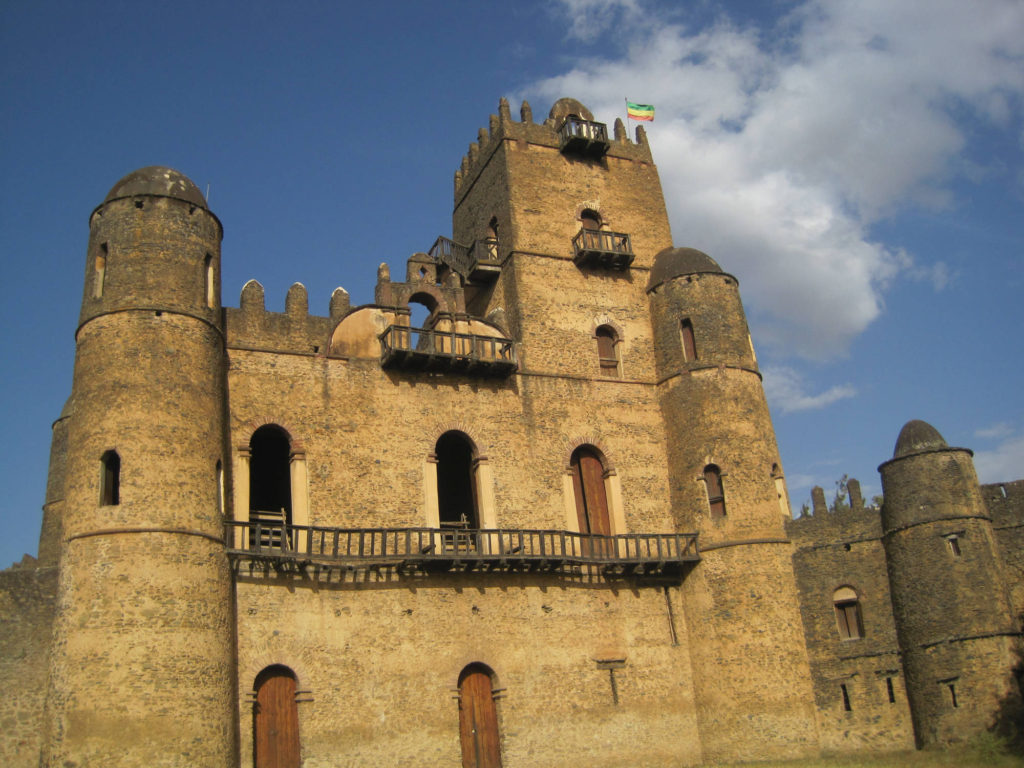
The Castle of Emperor Fasilidas – “The Camelot of Africa”
The graceful city of Gonder, embraced with incredibility, was founded by Emperor Fasilidas around 1635. It is famous for its many medieval castles, (constructed in the European middle age architectural style), and the design and decoration of its churches. An extensive compound, near Gonder’s center contains the massive ruins of a group of imposing castles like some African Camelot. The battlements and towers evoke images of gracious knights on horseback and of ceremonies laden with spectacle and honor. The oldest and most impressive of Gonder’s many imperial structures is the palace of Emperor Fasilidas, said to have been built by an Indian architect. There are also numerous other fascinating historical buildings and relics to be seen in the area.
Debre Berhan Selassie
Debre Berhan Selassie, in particular, represents a masterpiece of the Gonderene School of art. This finest Gonderene church was built during the reign of Emperor Iyasu ( 1682-1706), and was never destroyed. It is said that when the Dervishes tried to burn it in 1881, they were attacked and dispersed by bees. The church is rectangular, similar to those of ancient Axumite architecture. The inside walls of the front room are covered with paintings on cloth, glued to the surface. The ceiling is built with thick beams and it decorated with winged angel heads looking down. The wall paintings depict scenes from the life of Christ, Mary, the Saints, the Trinity, and others. The unique murals are awesome and have stood the test of time for centuries.
Flanked by twin mountain streams at an altitude of more than 2,300 meters, Gondar commands spectacular views over farmlands to the gleaming waters of Lake Tana. The city retains an atmosphere of antique charm mingled with an impression of mystery and violence. Gonder was once a vigorous and vital center of religious learning and art. For more than two hundred years skilled instruction in painting, music, dance, poetry and many other disciplines thrived. Fasilidas and his successors saw their elegant capital as a phoenix and so patronized the arts.
The treasures of Gonder include the stone bathhouse of Emperor Fasiladas and the ruined Palace of Kusquam. The castles display a richness in architecture that reveals the influence of Arabia as well as Axumite traditions, and are said to be the largest concentration of such structures in Africa.
Harar Tour
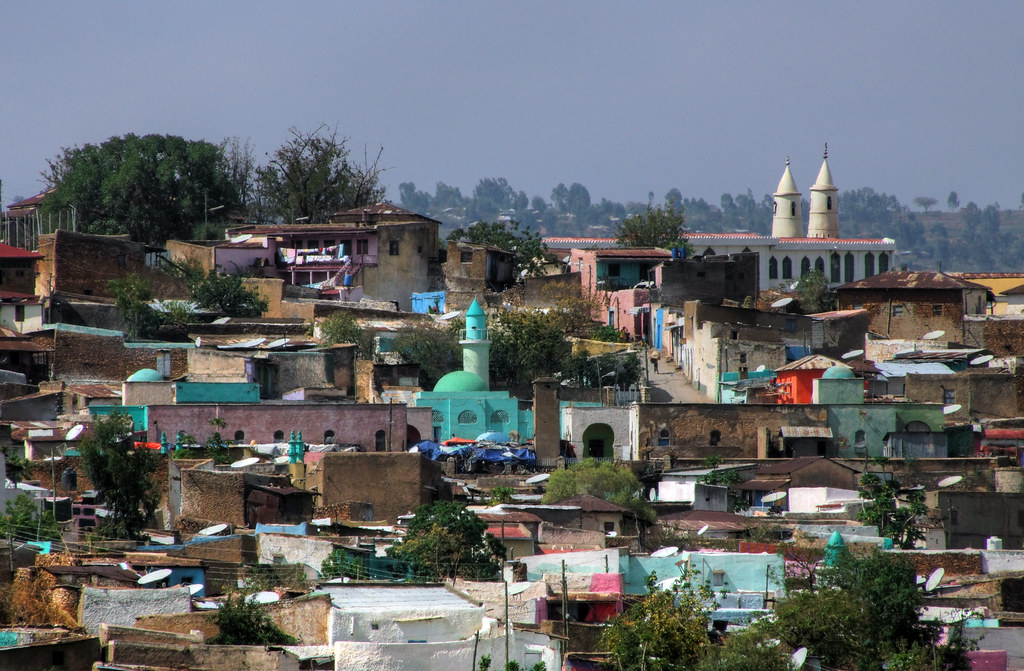
The Walled City
The eastern part of Ethiopia, close to Djibouti and Somalia, is a region inhabited mainly by Muslims. The ancient walled city of Harar has more than 90 mosques and shrines mixed in with households behind its sixteenth century walls. This city was founded over 1000 years ago, and is considered to be one of the holiest centers of Muslim learning in the Islamic world.
Harar, which is not too large to be visited on foot, is a place of unique and unforgettable charm and has much to offer to the discerning tourist. Walking down its narrow, cobble stoned and twisting lanes, one can easily feel transported back in time to the days of Richard Burton – or even earlier when Amir Nur constructed the city’s stout old walls.
Background History: From the base of Harar city, the strong Emir of Harar in the 1500s, Ahmed Gragn, rebelled against the domination of the highland Christian empire of Ethiopia to the west. Ahmed Gragn was defeated by the Christian ruler of the day, Emperor Gelawdeos, with the help of the Portuguese. In the vacuum left by the devastating battle between Harar and Christian Ethiopia, the fierce Oromo warriors advanced from the south, occupying much of central and northern Ethiopia, and up to the gates of Harar. Although the city withstood the assaults because of its reinforced walls, this independent trading city of Harar was left surrounded by an Oromo countryside. In the late nineteenth century, after a 10 year spell of Egyptian rule, the city state was conquered by the return of the Christian Empire of the highlands under the Emperor Menelik. The forces of Menelik were led by his cousin Ras Mekonen, the father of the late Emperor Haile Selassie. Haile Selassie was therefore born and raised in the Harar vicinity, and always considered it his original home.
Harar today, with its atmosphere of history and past glory amidst the ebb and flow of conquering armies, and its ethnically diverse population, is thus a fascinating stopping place for the traveler.
Lake Tana Tour
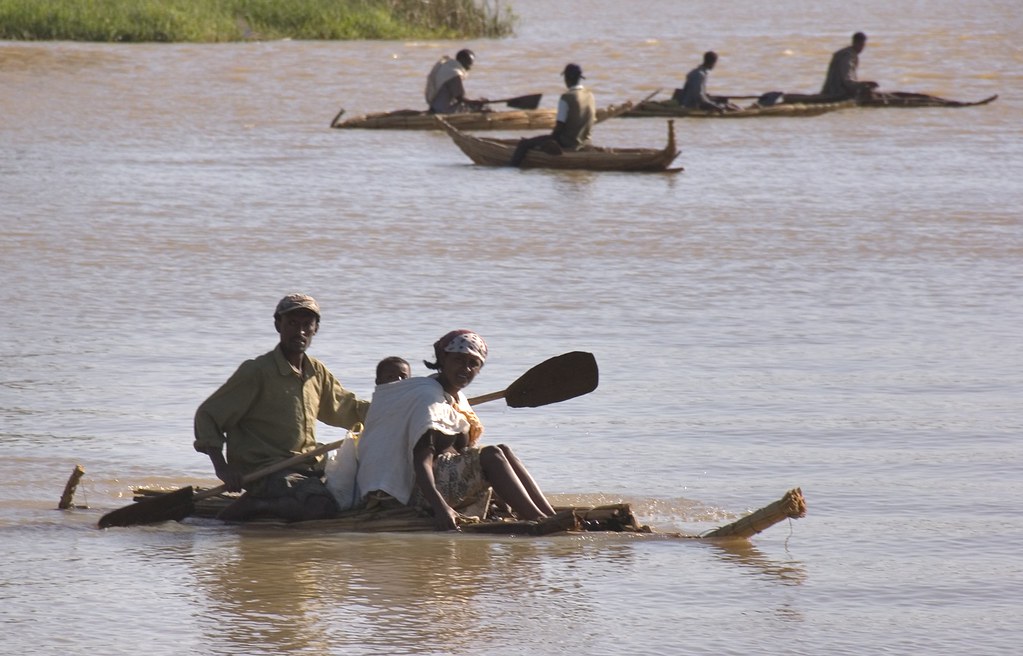
Monasteries and the Source of the Blue Nile River
There are 37 islands that are scattered about the surface of Lake Tana, out of which some 20 shelter churches and monasteries of immense historical and cultural interest. These churches are decorated with beautiful paintings and house innumerable treasures. Because of their isolation they were used to store art treasures and religious relics from all parts of the country.
Visiting the Churches
Access for some of the churches is closed to women, although they are allowed to land on the banks of the island but not permitted to proceed further. However women are permitted to visit churches on Zeghne Peninsula and nearby church of Ura Kidane Mehret, as well as Narga Sellassie.
Kebran Gabriel: is renowned for a magnificent manuscript to the Four Gospels which is believed to date back to at least the late fourteenth or early fifteenth century. Ura Kidane Mehret: is more decorative with a huge, conical thatched roof is painted with scenes from Biblical lore.
Daga Istifanos: is considered one of the most sacred on Lake Tana, and said to have served as a temporary hiding place for the Ark of the Covenant. On this stands the church of Saint Stifanos which houses the Holly Madonna painted around 1434. The real historic interest lies in its treasury where there are glass-sided coffins containing the mummified remains of several of the former emperors of Ethiopia.
Tana Cherkos: this ancient monastery is found on the eastern shore of Lake Tana. Tradition tells us that St. Mary rested here under a wall during her flight to Egypt, and stayed for three months and ten days. The monks claim that they owned a necklace which she left when she departed. It is also said that the monastery was a sacred place of the Jews. Menelik I and the Jewish nobles, after fleeing from King Solomon, brought the Ark of the covenant to this monastery and built a temple over it, which was decorated with precious stones. Six hundred years later, the Ark was brought to Axum.
